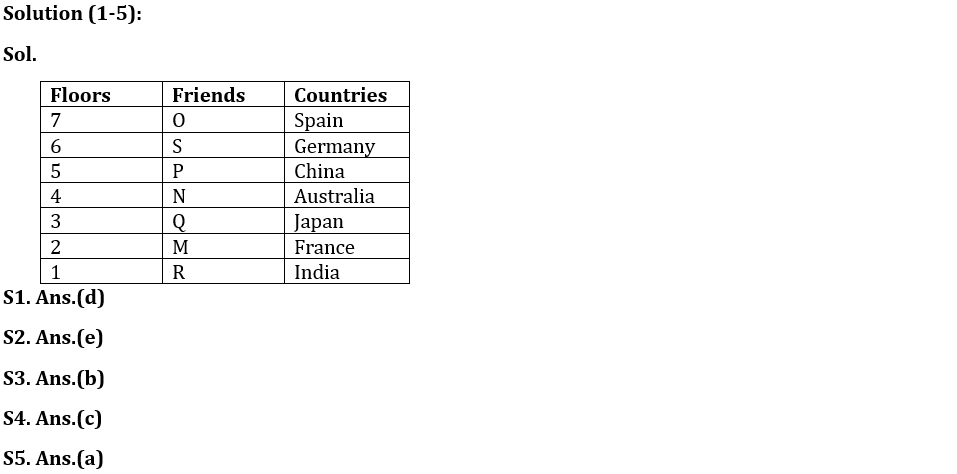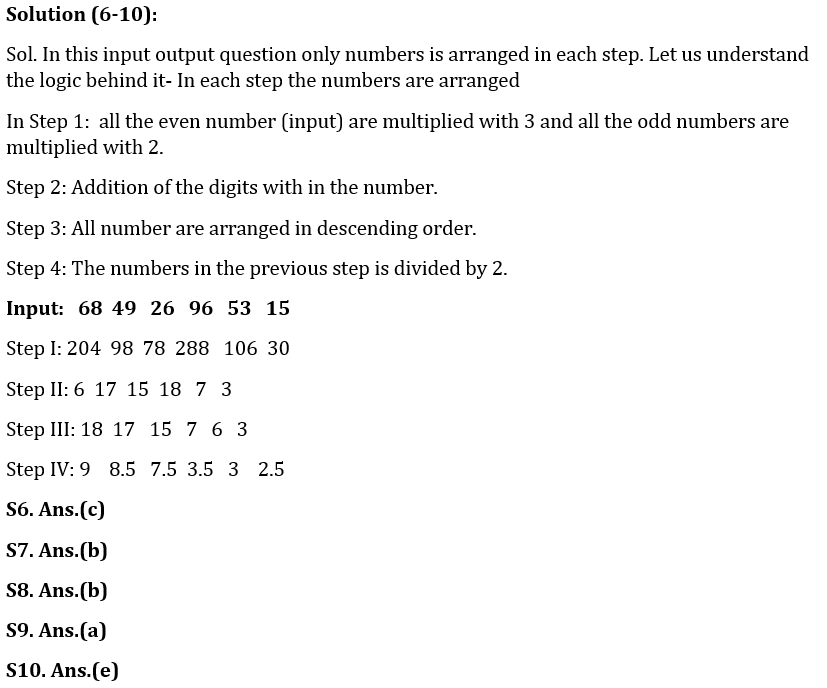Directions (1-5): Study the following information carefully and answer the question given below-
Seven persons are living on different floors of seven storey building. Ground floor is numbered as 1st and top floor is numbered as 7th floor, also they belong different countries. There are four floors in between S and R, who is from India. P lives on an odd numbered floor just above N, who doesn’t live on 2nd floor. The one who belongs to Japan and lives just above M. The one, who is from Spain, lives on an odd numbered floor. S does not live on ground floor. M does not belong to china. The one, who is from China lives on an odd numbered floor just above the one who is from Australia. S is not from Australia and France. O lives one of the floors above Q. Not more than one floor in between the one who belongs to Japan and the one who belongs to China. The one who belongs to Germany lives on an even numbered floor above P. S is not belongs to Japan.
![]()
Q1. Who among the following belongs to Germany?
(a) the one who lives on 4th floor
(b) M
(c) P
(d) The one who lives immediate below O
(e)None of these
Q2. How many persons lives in between O and M?
(a) Two
(b) Three
(c) None
(d) One
(e) More than Three
Q3. R lives in which of the following floor?
(a) 4th floor
(b) 1st floor
(c) 3rd floor
(d) 7th floor
(e) 6th floor
Q4. Which of the following statement is true?
(a) N lives on 6th floor
(b) P live immediate above Q
(c) M belongs to France
(d) S lives immediate below the one who belongs to china
(e) None is true
Q5. Who among the following person lives on 3rd floor?
(a) The one who belongs to Japan
(b) R
(c) the one who belongs to Spain
(d) S
(e) None of these
Directions (6-10): Study the given information and answer the questions:
When a number arrangement machine is given an input line of numbers, it arranges them following a particular rule. The following is an illustration of an input and its rearrangement.
Input: 45 39 64 53 89 74
Step I: 90 78 192 106 178 222
Step II: 9 15 12 7 16 6
Step III: 16 15 12 9 7 6
Step IV: 8 7.5 6 4.5 3.5 3
Step IV, is the last step of the above arrangement as the intended arrangement is obtained.
As per the rules followed in the given steps find out the appropriate steps for the given input:
Input: 68 49 26 96 53 15
Q6. What is the sum of the numbers at both the ends in step III of the given arrangement?
(a) 28
(b) 30
(c) 21
(d) 25
(e) None of the above
Q7. Which element is 2nd to the right of the one which is 4th to the left element in step I?
(a) 204
(b) 30
(c) 288
(d) 106
(e) None of these
Q8. What is the products of the numbers which is 3rd from the left end in IV step and 2nd from the right end in III step of the given arrangement?
(a) 37
(b) 45
(c) 25
(d) 48
(e) none of these
Q9. What is the difference between the numbers which is second from the left end and third from the right end in step II?
(a) 1
(b) 8
(c) 10
(d) 12
(e) 15
Q10. What is the difference of digits of the number which is fourth from the right in step I?
(a) 7
(b) 22
(c) 13
(d) 12
(e) 1
Directions (11-13): In these questions, relationship between different elements is shown in the statements. These statements are followed by two conclusions. Mark answer as
Q11. Statement: A≥M≥N=G>K, H>R=O≤N
Conclusion: I. A≥O II. H>K
(a) If only conclusion II follows.
(b) If only conclusion I follows.
(c) If both conclusion I and conclusion II follow
(d) If neither conclusion I nor conclusion II follows.
(e) If either conclusion I or conclusion II follows.
Q12. Statement: H≥R≤K>E≤S, E=D≥G
Conclusion: I. G≥R II. K>G
(a) If neither conclusion I nor conclusion II follows.
(b) If only conclusion I follows.
(c) If both conclusion I and conclusion II follow
(d) If only conclusion II follows.
(e) If either conclusion I or conclusion II follows.
Q13. Statement: P<Q≤R=S, U≥R≤M≤G
Conclusion: I. U≥Q II. G≥S
(a) If only conclusion II follows.
(b) If either conclusion I or conclusion II follows.
(c) If both conclusion I and conclusion II follow
(d) If neither conclusion I nor conclusion II follows.
(e) If only conclusion I follows.
Q14. Which alphabet is 3rd from the left in the meaningful four-letter word formed from the 1st, 2nd, 7th and 10th letter of the word PRODUCTION? If more than one word is formed, then mark answer as X and no meaningful word is formed then mark answer as Z.
(a) P
(b) Z
(c) R
(d) X
(e) U
Q15. If all the vowels of the word ‘VIOLENCE’ are replaced by its succeeding letter according to the English alphabet and all the consonant are replaced with their previous letter according to the English alphabet and then all the letters are arranged in the alphabetical order the how many letter are there between the third letter from the left and third letter from the right in the English alphabetic series?
(a) 5
(b) 6
(c) 2
(d) 10
(e) 4
Solutions


S11. Ans.(b)
Sol. I. A≥O(true) II. H>K(false)
S12. Ans.(d)
Sol. I. G≥R(false) II. K>G(true)
S13. Ans.(c)
Sol. I. U≥Q(true) II. G≥S(true)
S14. Ans.(b)
S15. Ans.(b)
Sol. Original Word- VIOLENCE
Obtained word- U J P K F M B F
After arrangement- B F F J K M P U





 GA Capsule for SBI Clerk Mains 2025, Dow...
GA Capsule for SBI Clerk Mains 2025, Dow...
 The Hindu Review October 2022: Download ...
The Hindu Review October 2022: Download ...
 IBPS Clerk Mains Cut Off 2025, Check Sta...
IBPS Clerk Mains Cut Off 2025, Check Sta...







